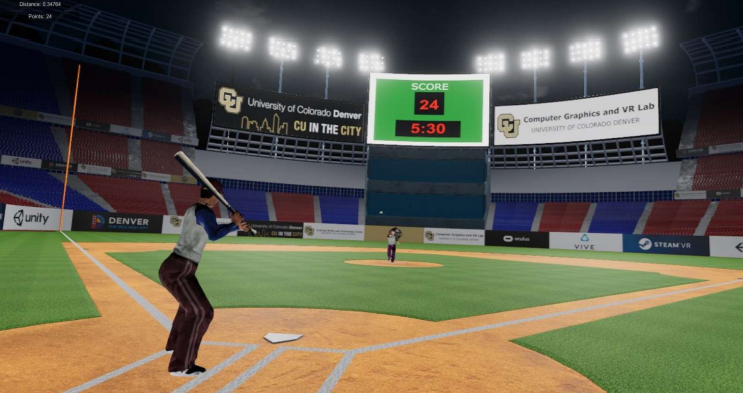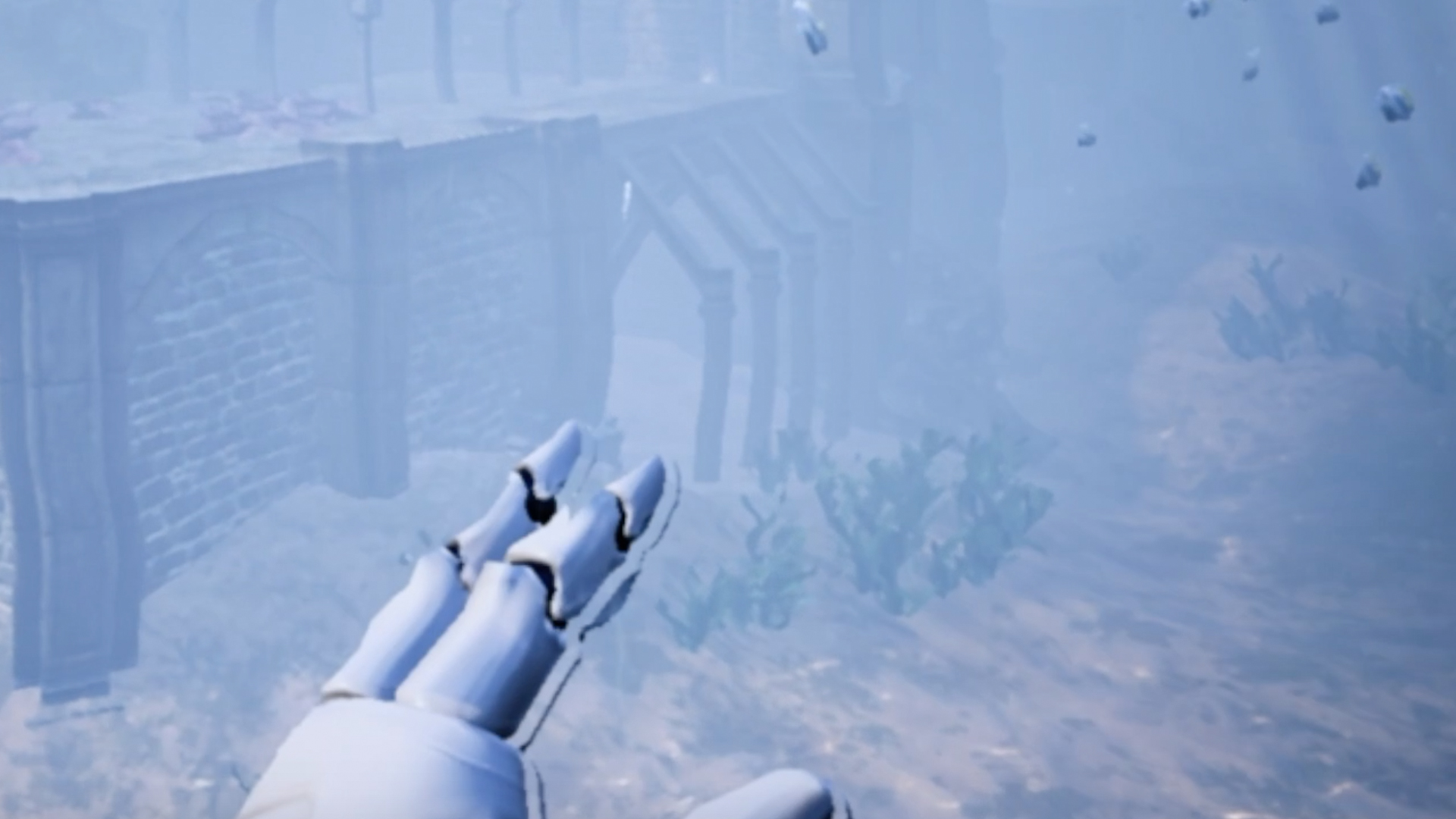Virtual and Augmented Reality
Table Tennis Performance Improvement Through Training in Virtual Reality



Description: We have developed a VR table tennis system to examine training transfer for skill-based sports. Using this system, we are studying how well participants apply techniques they learn in VR to the real-world game and determine the success of training transfer by taking both quantitative and qualitative measurements. We have simulated flying physics and built a realistic virtual table tennis prototype system in which the player is trained to play table tennis by returning balls shot by a ball launcher or an opponent (robot) in the virtual environment. The main training aspect of this platform is focused on increasing consistency which is by itself is based on several other aspects of playing techniques such as posture training and ball returning training. Experimental group and control group data (skeletal information, attention data, and reaction time) from pre- and post-training is analyzed to show the success of the training. A study was conducted to explore the learning and skill transfer process from VR to the real world. The results are very promising and have been submitted to a journal to be published. The main contribution of this study is, showing the validity of VR for sport-related training and transfer skills learned to the real world.
Download Links:
Video See-Through Augmented Reality with Passive Haptics for Vision Therapy



Description: Binocular vision disorders are prevalent in the general population, with approximately 5% having reduced ability or no ability to fuse the images from both eyes. Our research aims to improve binocular vision therapy outcomes through a new tool that blends passive haptics and video see-through augmented reality, to not only engage patient's vision, but also their proprioception. The patient can see and interact with the real world through stereo cameras on a VR headset, while AR content is blended with passive objects to create activities and games. The technology enabling this tool can be used for a variety of applications including education, training, and cognitive screening, and this research aims to contribute to the broader research conversation of the integrated roles of vision and proprioceptive in perception.
Download Links:
Neurocognitive Assessment in Virtual Reality Through Behavioral Response Analysis


Description: The ability to detect and diagnose neurocognitive disorders at the earliest possible moment is key to a better prognosis for the patient. Two of the earliest indicators of potential neurocognitive problems are motor and visual dysfunction. Motor disorders and problems in visual cognition can be seen in many neurocognitive disorders, resulting in abnormal physical reactions to visual stimuli. Analyzing physical behaviors when presented with such stimuli can provide insights into the visual perception and motor abilities of an individual, yet there is currently no unbiased, objective, general-purpose tool that analyzes attention and motor behavior to assess neurocognitive function. We propose a novel method of neurocognitive function assessment that tests the patient's cognition using Virtual Reality (VR) with eye tracking and motion analysis. By placing the patient in a controlled virtual environment and analyzing their movements, we can evoke certain physical responses from subjects for neurocognitive assessment. We have developed a prototype system that places the subject in a virtual baseball field and captures their full body motion as they try to catch baseballs. This scenario tests the subject's ability to determine the landing time and position of the ball, as well as the test subject's balance, motor skills, attention, and memory. Preliminary tests with 20 healthy normal individuals demonstrate the ability of this tool to assess the test subject's balance, memory, attention, and reaction to visual stimuli. This platform has a twofold contribution: it is used to assess several neurocognitive constructs that affect visual and motor capability neutrally and objectively based on controlled stimuli, and it enables objective comparison between different neurocognitive disorders research in this field.
HoloNav: An Indoor Navigation HoloLens App
Members:
Kushal Kusram


Description: An indoor navigation HoloLens app that utilizes on-board cameras and spatial sensors to perform spatial mapping to help an end-user navigate floor of the Department of Computer Science. The floor was previously registered using HoloLens generating a 3D Mesh Map which was used to anchor 10 rooms (labs) on the same map. HoloNav’s UI presents user a list of options to choose a destination. HoloNav can load the anchor in the pre-mapped mesh and has the ability to point a navigational arrow while displaying distance from entered destination.
Download Links:
[ YouTube ]
VRInsole: An Unobtrusive and Immersive Mobility Training System for Stroke Rehabilitation



Description: Stroke is a leading cause of long-term impairment, causing a fatality if not act upon in time. Home-based post-stroke rehabilitation plays an important role in helping patients to regain normal mobility and functionality at their residence. However, existing home-based rehabilitation approaches fail to effectively motivate patients on frequent engagement with exercise to achieve the intended outcome. In this paper, we develop VRInsole, a synthetical solution combining a Smart Insole footwear sensor and virtual reality (VR) , targeting lower extremity mobility training in an immersive environment for stroke rehabilitation. Specifically, the motion information collected from the Smart Insole serve as the input for the VR to perform corresponding exercise animations. To prove the feasibility of VRInsole, an evaluation is conducted on the recognition of lower extremity motion direction, which achieves an average accuracy of 93.9%.
Download Links:
[ PDF ]
VR Collaborative Conceptual Design
Members:
Christopher Renden,
Jordan Stein,
Lewis Sammons,
Min-Hyung Choi



Description: In modern conceptual design, there is an important disconnect between real-world interactions (motions, dexterity, precision, accuracy, etc.) and the interfaces provided by virtual and augmented reality interfaces and control metaphors (the simplified controls we use to interact with virtual environments). The level of generality provided by most control metaphors are a great oversimplification of the natural techniques and movements that we naturally use to interact with the real-world. This research introduces new intuitive controls that play a pivotal role in the adaptation of virtual and augmented reality interfaces for domain-independent composition and implementation of arbitrary design concepts.
Download Links:
[ N/A ]
SwimVR: Improving swimming techniques and endurance



Description: Interactive training environments provide a foundation for establishing the fundamentals of various tasks including effective swimming techniques. This project explores continuous underwater swimming motion and behavioral analysis and arm movement efficiency though an interactive and game-centric interface that encourages continuous movement through gameplay. This simulation can aid in the improvement of physical motion and continuous physical activity (through continuous swimming) to improve endurance.
Download Links:
[ N/A ]
